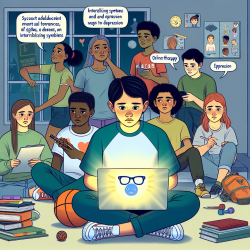Introduction
The landscape of adolescent time use has undergone significant transformations over the past few decades, with notable shifts in parental supervision, social activities, and engagement in structured activities. These changes have sparked interest among researchers and practitioners alike, particularly in relation to their impact on adolescent mental health. A recent study, "Time use and associations with internalizing symptoms from 1991 to 2019 among US adolescents," offers valuable insights into these dynamics, presenting opportunities for practitioners to enhance their approaches to adolescent mental health.
Understanding the Research
The study conducted a comprehensive analysis of adolescent time use patterns over a span of nearly three decades, utilizing data from the Monitoring the Future surveys. Researchers identified six distinct groups based on time use patterns, including part-time and full-time workers, as well as varying levels of social activity engagement. The findings highlighted that lower socialization and engagement in activities such as sports, academics, and community service were predictors of higher internalizing symptoms, including depression.
Key Findings and Implications
One of the critical takeaways from the study is that while shifts in adolescent time use patterns have occurred, they only partially explain the increase in depressive symptoms. Internalizing symptoms were most prevalent among adolescents with low socialization and those engaged in substantial work hours. Practitioners can leverage these findings to tailor interventions that encourage socialization and engagement in structured activities, which may help mitigate the risk of internalizing symptoms.
Actionable Steps for Practitioners
- Encourage Socialization: Facilitate opportunities for adolescents to engage in social activities, both in-person and online. Creating safe and supportive environments for social interaction can help reduce feelings of isolation.
- Promote Structured Activities: Encourage participation in sports, academic clubs, and community service. These activities not only provide structure but also foster a sense of belonging and purpose.
- Monitor Work Hours: For adolescents engaged in part-time or full-time work, ensure that their work hours do not interfere with social and recreational activities, which are crucial for mental well-being.
- Utilize Online Platforms: Leverage digital tools and platforms to provide remote therapy sessions and mental health resources, ensuring accessibility even during times when in-person interactions are limited.
Encouraging Further Research
While the study provides a foundational understanding of adolescent time use and its association with mental health, there remains a need for further research to explore the nuances of these relationships. Practitioners are encouraged to contribute to this body of knowledge by conducting studies that examine the impact of digital socialization, the role of parental supervision, and the effectiveness of various interventions in different demographic contexts.
Conclusion
As the field of adolescent mental health continues to evolve, practitioners must remain informed about the latest research and trends. By integrating the findings from studies like this one into their practice, they can better support adolescents in navigating the complexities of modern life. For those interested in delving deeper into the research, the original paper can be accessed here: Time use and associations with internalizing symptoms from 1991 to 2019 among US adolescents.










